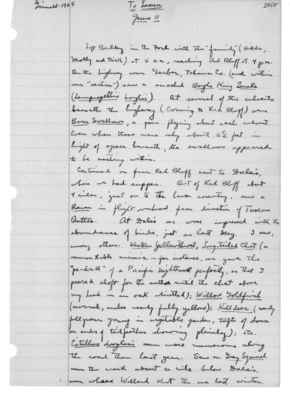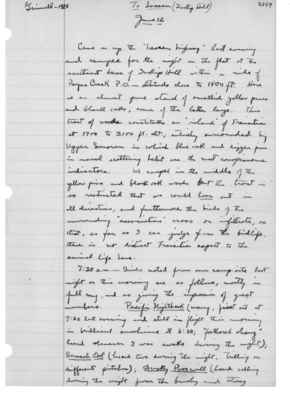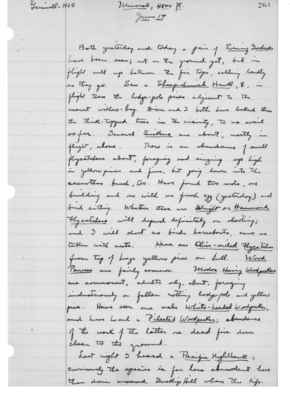Pages That Mention Pacific nighthawk
1925: Joseph Grinnell's field notes
S2 Page 2
Collector: Grinnell - 1925 Location: Lassen Section Date: June 11, 1925 Page Number: 2458
Left Berkeley in the Ford with the "family" (Hilda, Molly and Dick) at 5 a.m., reaching Red Bluff at 4 p.m. on the highway near Gerber, Tehama Co. (and within our "section") saw a smashed Boyle King Snake (Lampropeltis boylii). At several of the culverts beneath the highway (Corning to Red Bluff) were Barn Swallows, a pair flying about each culvert. Even when these were only about 2 1/2 feet in height of space beneath, the swallows appeared to be nesting within. Continued on from Red Bluff east to Dale's, where we had supper. Out of Red Bluff about 4 miles, just on to the lava country, saw a Raven in flight overhead from direction of Tuscan Buttes. At Dale's we were impressed with the abundance of birds, just as last May. I saw, among others: Western Yellowthroat; Long-tailed Chat (a remarkable mimic - for instance, one gave the "pe-ark" of a Pacific nighthawk perfectly, so that I peered aloft for the author until the chat above my head in an oak whistled); Willow Goldfinch (several, males nearly fully yellow); Killdeer (nearly fullgrown young in vegetable garden, tufts of down on ends of tailfeathers showing plainly); etc. Citellus douglasi seem more numerous along the road than last year. Saw an Gray Squirrel near the creek about a mile below Dale's, near where Willard shot the one last winter.
S2 Page 3
Collector: Grinnell - 1925 Location: To Lassen (Inskip Hill) Date: June 12, 1925 Page Number: 2459
Came on up the "Lassen highway" last evening and camped for the night on the flat at the southeast base of Inskip Hill within a mile of Payne Creek P.O. - altitude close to 1800 ft. Here is an almost pure stand of smallish yellow pines and black oaks, some of the latter large. This tract of woods constitutes an "island" of transition at 1700 to 2100 ft. alt., entirely surrounded by Upper Sonoran in which blue oak and digger pine in usual scattering habit are the most conspicuous indicators. We camped in the middle of the yellow pine and black oak woods but the tract is so restricted that we could hear out in all directions, and furthermore the birds of the surrounding "associations" cross or infiltrate, so that, as far as I can judge from the birdlife, there is no distinct transition aspect to the animal life here. 7:30 a.m. - Birds noted from our campsite last night or this morning are as follows, mostly in full song, and so giving the impression of great numbers. Pacific Nighthawk (many, first out at 7:20 last evening and still in flight this morning in brilliant sunshine at 6:30; "feathered whang" heard whenever I was awake during the night); Screech Owl (heard two during the night, trilling in different pitches); Dusky Poorwill (heard calling during the night from the bushy and stony
S2 Page 7
Collector: Grinnell - 1925 Location: Lassen Section (Mineral) Date: June 14, 1925 Page Number: 2463
Both yesterday and today a pair of Evening Grosbeaks have been seen; not on the ground yet, but in flight well up between the fir tops, calling loudly as they go. Saw a Sharp-shinned Hawk, female, in flight thru the lodge-pole pines adjacent to the nearest willow-bog. Dixon and I both have looked thru the thick-topped trees in the vicinity, to no avail so far. Several Siskins are about, mostly in flight, above. There is an abundance of small flycatchers about, foraging and singing up high in yellow pines and firs, but going down into the ceanothus bush, too. Have found two nests, one building and one with one fresh egg (yesterday) and bird sitting. Whether these are Wright or Hammond Flycatchers will depend definitely on shooting; and I will shoot no birds hereabouts, save any (?) taken with nests. Hear one Olive-sided Flycatcher from top of huge yellow pine on hill. Wood Pewees are fairly common. Modoc Hairy Woodpeckers are commonest, adults only, about, foraging industriously on fallen rotting lodge-pole and yellow pine. Have seen one male White-headed Woodpecker, and have heard a Pileated Woodpecker; abundance of the work of the latter on dead firs down clean to the ground. Last night I heard a Pacific Nighthawk; curiously this species is far less abundant here than down around Inskip Hill where the life-


